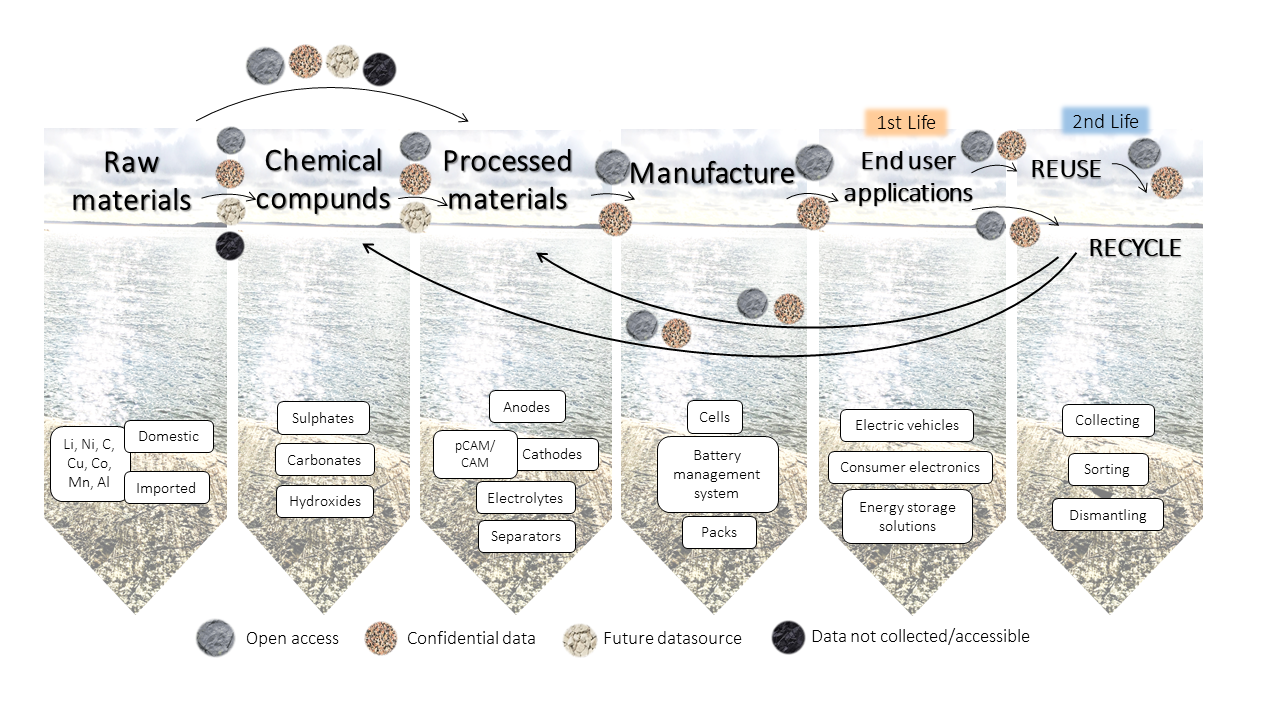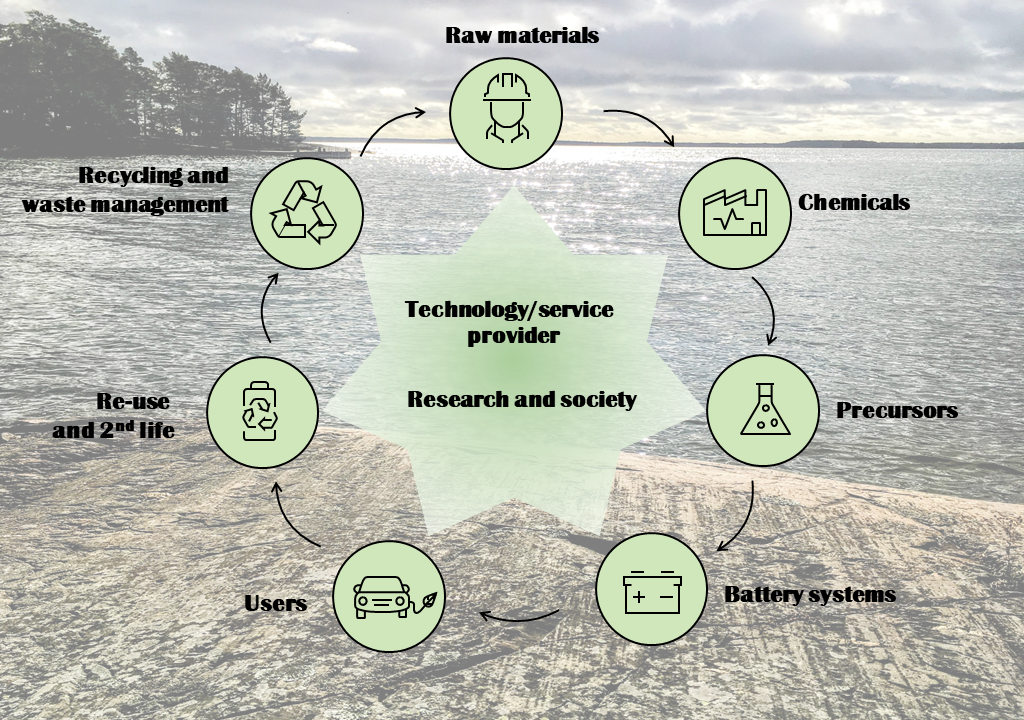Quality Replaces Quantity When the Flood of Data in the Battery Value Chain Is Utilised
The rapid increase in consumption already awakened the need for material recycling in the last millennium. As the need for recycling was noticed a little later than production itself, it was not part of the beginning of the products’ life cycle, but in many cases became part of the aftercare. An actual material cycle is best achieved when it is planned as part of the entire product’s life cycle, and functions as part of production from the beginning. The most effective result is achieved when both basic information and constantly updated data about the matter are planned. Public actors collect data quite widely, but as the product moves forward in its life cycle, the amount of data collected decreases considerably.

Data on materials and material flows are and have been collected for a long time for reasons completely different from circular economy ones. Despite its original purpose, the same information can also be utilised to promote the circular economy.
There are a lot of data, in some places even more than necessary, so here quality really overrides quantity. It is essential to identify the materials that are useful. Industries that have existed for a long time are further along in the development of their material chains than newer goods – for example, the food industry compared with the battery industry. Humanity has consumed food significantly longer than it has used electronic devices, so both knowledge and consumers’ product awareness are significantly more comprehensive in the material flows of food supplies.
However, newer commodities have the advantage of following the path indicated by earlier ones. It is unnecessary to reinvent the wheel, and it is possible to learn from others’ mistakes, as well as their success. Industry therefore has many tools in its hands that enable recyclability and material efficiency, and they can be considered immediately at the design table.
Towards a more sustainable future with the aid of openness and cooperation
However, a path that sounds so easy in theory becomes quite challenging in today’s world because of the great variety of data available. Some of the useful information is easy to find and openly available, some can be obtained by asking separately having tracked down the owner of the data, and some is simply inaccessible.
The reason is not so much the need to hide information as the fact that the amount of data to be hidden is a fraction of what is produced, but in the definitions of the legislation and the lack of platforms for sharing information. For a large part of the one-time collected information, there has not been a wider demand than the original purpose, so its publication has been unnecessary. However, with similar data from other operators, it can form a more comprehensive entity, based on which it will be possible to develop and improve processes.
“90% of all our data could be open access” – Stakeholder in the battery value chain
Easily found and open data not only give this opportunity, but also the basis for new business models and innovative intermediaries, for whom the promotion of the circular economy is a core activity. In this picture, the Geological Survey of Finland’s open geodatabase means it plays several roles as a data producer, user, and data broker.
In the prevailing situation of the mineral economy, we cannot afford to turn a blind eye. Comprehensive, up-to-date and comparable information is a prerequisite for developing tools and solving problems. Based on this idea, the Geological Survey of Finland has produced a handbook (Kauppila et al. 2022) as part of the Circular Design Network project, which makes it possible to promote a data-based circular economy from the very beginning of product design.

Data produced by the battery value chain divide opinions
Transparent, energy-efficient, recyclable and recycled – both consumers and legislators expect and ask product makers to act more consciously than before, as growing consumption reduces material reserves. What will this mean in different fields, what will the actors have to contribute, and what will they themselves hope to gain from it? And what role do data play in all this?
“Finding solutions of sufficient value is a problem” – Stakeholder in the battery value chain
The researchers of the Circular Design Network project set out to find out. They got direct answers to their direct questions. From the perspective of the circular economy, the requirements for conscious operations are in place, and based on the research conducted, a large part of the operators themselves feel these operations are necessary. We are well on our way, but information sharing, tools and cooperation are required to get to the finish line.
There is no magic tool to solve circular economy challenges
It immediately became clear that there is no miraculous tool that will work as a collective solution. Depending on the sector, the organisation and many other factors, the role the circular economy plays in the processes varies quite a lot. In addition to this variety, the role of data also complicates the matter, as it is a key factor for some and a necessary evil for others.

Digitalisation is a growing trend, but the collection, processing and sharing of information is sometimes a little fragmented. And why wouldn’t that be the case when we’re just gaining momentum? The information collected in some fields has generally been reported digitally only in the twenty-first century, and only in recent years in a uniform format. Because of this, finding information from previous decades can be difficult.
Some actors like the Geological Survey of Finland are working on saving old data and converting it from paper to digital format, but it takes time. In addition, the recordings are in several different formats, and there is a lack of a common platform for circular economy information. Information whose secrecy is justified for one reason or another brings its own challenge. Among other things, it is therefore challenging to create an overall picture of the actions that take place in the value chain of battery data.
In addition to consumers, many operators consider it important to be able to trace the origin of the material, both for production efficiency and ethical reasons. It is therefore important to consider the flow of information in both directions in the chain. And more challenges are encountered as soon as you go outside the country’s borders. There are differences in country-specific practices regarding the collection, storage and sharing of information.
Data help control the production chain nearly in real time
Research information on the basic properties of materials is seen as an important part of the chain, meaning essential issues can already be considered in the design phase of new products and processes. For example, it is possible to prepare for the lifetime optimisation of the equipment and the reuse potential of the material by being aware of possible stumbling blocks and reacting before it is too late. In relation to these, not only preliminary research data, but also real-time monitoring data and their immediate availability are essential. It is also important to remember that even if the collected data are not immediately useful, the research carried out is nevertheless valuable and may even be an important part of future databases. The loss of collected information must therefore be avoided, and data must be stored in a form that enables digital sharing and discoverability.
The effort for a more sustainable world creates a need for expertise in the efficient utilisation of data. Information floods in through doors and windows, and the operator himself does not always have the skill or the time to get creative with it. There is therefore room in many fields for those who want to use their own expertise to support the enhancement of the circular economy from the data perspective.
GTK is involved in the study of the battery value chain of the Circular Design Network project. The Circular Design Network project combines the expertise, research knowledge and business opportunities of various actors by developing access to open data, information, and research results in cooperation with stakeholders. The possibilities of using system-level understanding in planning and developing optimised circular economy solutions are key when CircDNet aims to identify gaps and opportunities in different value chains.
Additional information about the Circular Design Network project is available from Sonja Lavikko, sonja.lavikko@gtk.fi and Tommi Kauppila, tommi.kauppila@gtk.fi
Text
Sonja Lavikko, Research Scientist (PhD – Geology), GTK, sonja.lavikko@gtk.fi
References
Orko, I. (Ed.), Heikkilä, L., Häikiö, J., Järvinen, S., Karhu, M., Klein, J., Lantto, R., Lavikka, R., Lavikko, S., Lehtonen, E., Luostarinen, S., Mäkelä, S-M., Ovaska, J-P., Patala, S., & Winquist, E. (2022). Towards a Data-driven Circular Economy: Stakeholder Interviews. VTT Technical Research Centre of Finland. VTT Technology No. 400 https://doi.org/10.32040/2242-122X.2022.T400
Kauppila, T. (Ed.), Berg, A., Dahlbo, H., Eilu, P., Heikkilä, P., Hentunen, A., Hilska-Keinänen , K., Horn, S., Ilvesniemi, H., Jenu, S., Karhu, M., Karppinen, T. K. M., Kauppi, S., Kivikytö-Reponen, P., Lavikko, S., Lehtonen, E., Luostarinen, S., Majaniemi, S., Malmi, P., … Valtanen, K. (2022). Handbook for a Data-Driven Circular Economy in Finland: Data Sources, Tools, and Governance for Circular Design. VTT Technical Research Centre of Finland. VTT Technology No. 401 https://doi.org/10.32040/2242-122X.2022.T401
Circular Design Network. Finnish Environment Institute > Circular Design Network (CircDNet) (syke.fi)
